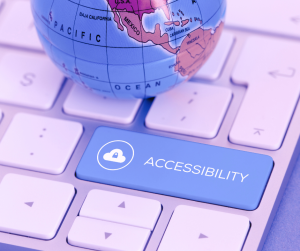Whether creating a course online or performing maintenance on an existing course, now is the time to review for accessibility. Accessibility means creating your online course with tools that help all learners access the information. Some states and organizations require courses to meet specific guidelines and requirements such as Section 508 and WCAG 2. If you’re not sure how to meet those requirements, we can help.
Here are three tips to help you make your online courses more accessible and inclusive:
YOU MIGHT ALSO LIKE: The Value of ADA Compliance & Accessibility in Online Courses
Maintain and Regularly Update Course Materials
Textbooks, course readers, journals, online materials need to be updated with accessibility and inclusion in mind. These updates include double-checking links to videos, articles, and PDFs. Certain learning management systems have link validation tools you can use to ensure students have all the resources they need and when they need them. Ensuring you have the latest teaching tools and up-to-date information sets learners up for success and promotes a much more positive and inclusive learning environment.
Here are a few more tips for resources.
- When creating links, replace long URLs with text that tells the learners what the resource is.
- Ensure that links are clear so students know where to click.
- Check that video and audio files use closed captions or transcripts and that alt text is present for images.
Implement Person-First Language
 Person-first language emphasizes the person, not the disability. This is in contrast to identity-first language, which focuses on disability. Instructors can incorporate these terms into written and verbal communications.
Person-first language emphasizes the person, not the disability. This is in contrast to identity-first language, which focuses on disability. Instructors can incorporate these terms into written and verbal communications.
An example of this would be using, “people with disabilities” instead of “the disabled”. Or “person with a mental health condition” instead of using “mentally ill”. Implementing these small changes to the language you use while teaching your course is essential in creating a positive learning space.
Utilize Universal Design for Learning (UDL)
UDL is an educational framework that promotes accessible and inclusive learning experiences for all students based on scientific insights into the ways people from all walks of life learn.
It emphasizes providing multiple means of representation, engagement, and expression to accommodate diverse learning preferences and abilities. Incorporating UDL principles into online course design can significantly enhance the learning experience and accessibility while allowing students to feel more active and engaged throughout their educational experience.
As you plan your next course, consider how you can implement updating your course materials, person-first language, and UDL for a more accessible and inclusive learning environment.
Angela Britcher
Latest posts by Angela Britcher (see all)
- Boost Your Teaching Career with Online Courses - May 16, 2024
- 7 Reasons to Use an LMS for Compliance Training - May 9, 2024
- Teach for Free with Edusity: Empowering Educators Worldwide - April 25, 2024